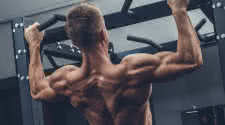Pullups vs Chinups Difference | Muscles Involved

Browse Key Aspects like Warmup, Technique and Kinesiological Analysis
WARMUP
Perform general side and back stretches, then two sets of low-resistance lat pulldowns or bent-over rows for 10 reps at 45 and 50 percent of your one-rep max.SPOTTING TECHNIQUES
Spotting for pullups requires substantial upper - and lower-body strength and is quite difficult, especially when you're spotting large people.Stand behind the lifter, placing your hands on the back of his or her waist to help the lifter into the starting position. Don't let go until the lifter's hands are fully secured. You'll probably need to help the most during the concentric phase, but avoid grabbing his or her feet or legs.
Use your lower body to do the work. Try not to get too far underneath him or her, as this will force you to arch your back. Be sure to bend your knees and contract your abs to protect your lower back.
PERFORMANCE
Grasp the chinup or pullup bar with a pronated, or overhand, shoulder-width grip. Use a spatter to help you get into the starting dead-hang position. To get full elbow extension, don't let your feet touch the floor.Slowly pull your body up so your chin is over the bar and your chest touches it. Don't kick up or thrust during the concentric phase.
Pause for a full one-second count. Then slowly return to the fully extended starting position. Pause deliberately and repeat.
Be kind to your joints, especially at the bottom of the movement. Exhale when pulling up and inhale when extending.
KINESIOLOGICAL ANALYSIS
The most common mistake made on this movement is failing to start from a dead-hang position before each repetition. Beginners often compensate for a lack of upper-body strength by kicking, thrusting or hinging during the hard part of the exercise or by limiting the range of motion.As with lat pulldowns and bent-over rows you can use a variety of hand positions on pullups. Use a pronated grip with either wide or shoulder-width hand spacing. A shoulder-width grip more fully taxes the lats and teres major. If you pull your head to the bar, you more heavily engage the pectoral muscles.
With a wide grip you have the option of pulling either your chest or your shoulders to the bar. By touching the bar low on your shoulders, you shift the stress more to the rear-delt, infraspinatus and teres minor muscles.
Use a supinated, or palms-up, grip only with a narrow, shoulder-width hand spacing. This type of hand position places more stress on the muscles of the anterior arm, the biceps and brachialis but less on those of the posterior forearm, the brachioradialis.
DO's and DON'Ts
» Do start from a dead-hang position.» Do touch your back or upper back to the bar.
» Do pause deliberately for a full one-second count.
» Don't sway, thrust or jerk your chest or upper back to the bar.
» Don't arch your chin above the bar.